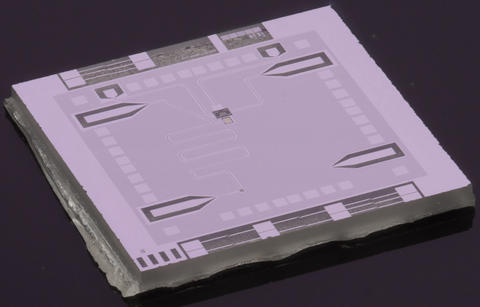
NIST's "optics table on a chip" is a superconducting circuit on a square sapphire chip about 6 millimeters wide. Scientists use the chip to place a single microwave photon in two frequencies, or colors, at the same time. The photon is prepared by an "artificial atom" (small yellow square) in the middle of the chip. The arrow shape at the lower left connects to a transmission line used to tune the SQUID (small black area near the point of the arrow). The SQUID couples together two resonant frequencies of the cavity (meandering line), and the photon oscillates between different superpositions of those frequencies.
Researchers at the National Institute of Standards and Technology (NIST) have created a tunable superconducting circuit on a chip that can place a single microwave photon (particle of light) in two frequencies, or colors, at the same time.
This curious "superposition," a hallmark of the quantum world, is a chip-scale, microwave version of a common optics experiment in which a device called a beam-splitter sends a photon into either of two possible paths across a table of lasers, lenses and mirrors. The new NIST circuit can be used to create and manipulate different quantum states, and is thus a prototype of the scientific community's long-sought "optics table on a chip."
Described in Nature Physics, the NIST experiments also created the first microwave-based bit for linear optical quantum computing. This type of quantum computer is typically envisioned as storing information in either the path of a light beam or the polarization (orientation) of single photons. In contrast, a microwave version would store information in a photon's frequency. Quantum computers, if they can be built, could solve certain problems that are intractable today.
The new NIST circuit combines components used in superconducting quantum computing experiments—a single photon source, a cavity that naturally resonates or vibrates at particular frequencies, and a coupling device called a SQUID (superconducting quantum interference device). Scientists tuned the SQUID properties to couple together two resonant frequencies of the cavity and then manipulated a photon to make it oscillate between different superpositions of the two frequencies. For instance, the photon could switch back and forth from equal 50/50 proportions of both frequencies to an uneven 75/25 split. This experimental setup traps photons in a "box" (the cavity) instead of sending them flying across an optical table.
"This is a new way to manipulate microwave quantum states trapped in a box," says NIST physicist José Aumentado, a co-author of the new paper. "The reason this is exciting is it's already technically feasible to produce interesting quantum states in chip-scale devices such as superconducting resonators, and now we can manipulate these states just as in traditional optics setups."
NIST researchers can control how the new circuit couples different quantum states of the resonator over time. As a result, they can create sequences of interactions to make simple optical circuits and reproduce traditional optics experiments. For example, they can make a measurement tool called an interferometer based on the frequency/color of a single photon, or produce special quantum states of light such as "squeezed" light.
E. Zakka-Bajjani, F. Nguyen, M. Lee, L.R. Vale, R.W. Simmonds and J. Aumentado. Quantum superposition of a single microwave photon in two different 'colour' states. Nature Physics. Posted online July 3, 2011.

